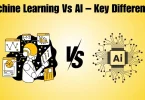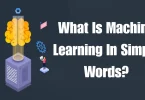According to the Future of Jobs Report 2025 by the World Economic Forum, machine learning is one of the fastest-growing and most in-demand skills across all industries. And let’s be honest—it’s everywhere. Whether it’s your phone unlocking with facial recognition, Spotify suggesting your next favorite song, or Google Maps optimizing your route in real time, machine learning is quietly working behind the scenes to make your life easier.
But if you’re just getting started, the field can seem overwhelming. Between complex algorithms, confusing math, and a flood of coding jargon, it might feel like trying to bake a fancy cake without a recipe—or even an oven.
Here’s the good news: you don’t need to know everything to begin. You just need to start small and build from there. That’s exactly where the best machine learning projects for beginners come in.
In this article, we’ll break down simple, practical ML project ideas that you can actually build—step-by-step. These projects are perfect if you’re a student curious about data, a professional looking to upskill, or just someone who loves solving problems with technology.
Let’s get you from curious to confident—one project at a time. Ready to dive in?
Why Start with Machine Learning Projects?

Before jumping into the project ideas, let’s answer a simple question: why work on machine learning projects?
Here’s why:
- They give you hands-on experience beyond theory.
- You build a portfolio to impress recruiters.
- They help you understand how real-world data is cleaned, analyzed, and used.
- You learn how to choose the right algorithms and evaluate model performance.
- Most importantly—you gain confidence.
Tools You’ll Need to Start
You don’t need a high-end setup or paid tools to begin working on the best machine learning projects for beginners. Here’s a quick list:
- Python: Most beginner ML projects are done in Python.
- Jupyter Notebook: Interactive coding environment for ML tasks.
- Libraries: NumPy, Pandas, Scikit-learn, Matplotlib, Seaborn
- Kaggle: For datasets and competitions
- Google Colab (optional): Run ML code in the cloud for free
23+ Best Machine Learning Projects for Beginners

Now let’s dive into the fun part—actual project ideas!
1. Iris Flower Classification
Objective: Predict the species of an iris flower using petal and sepal features.
Why it’s beginner-friendly:
This classic project uses a small and clean dataset with only four features. It’s ideal for learning how to apply classification models like Logistic Regression or K-Nearest Neighbors.
Skills You’ll Learn:
- Data visualization
- Train/test splitting
- Model evaluation (accuracy, confusion matrix)
Tools:
Python, Scikit-learn, Matplotlib, Seaborn
2. Titanic Survival Prediction
Objective: Use passenger data to predict who survived the Titanic disaster.
Why it’s beginner-friendly:
The dataset includes numerical and categorical features, perfect for learning preprocessing, feature engineering, and binary classification.
Skills You’ll Learn:
- Handling missing data
- Label encoding
- Logistic Regression
- Decision Trees
Tools:
Python, Pandas, Scikit-learn, Kaggle dataset
3. Spam Detection in Emails
Objective: Identify whether a message is spam or not using text classification.
Why it’s beginner-friendly:
It introduces you to Natural Language Processing (NLP), which is essential in modern machine learning applications like chatbots and sentiment analysis.
Skills You’ll Learn:
- Text cleaning and tokenization
- Vectorization (TF-IDF, CountVectorizer)
- Naive Bayes classifier
Tools:
Python, Scikit-learn, NLTK
4. Stock Price Prediction
Objective: Predict future stock prices based on past trends.
Why it’s beginner-friendly:
Time-series projects are a great intro to regression and forecasting. You’ll learn how trends and patterns help in predicting real-world data.
Skills You’ll Learn:
- Linear Regression
- Moving averages
- Data visualization (line plots)
Tools:
Python, Pandas, Matplotlib, Scikit-learn
You may also like to read this:
How To Create A Strong Password That’s Secure And Easy
Realme Vs Samsung Budget Phone Review: Full Comparison
Best Tablets For Reading And Work: 2025’s Top 5 Compared
Beginner Guide: What Is Machine Learning In Simple Words?
Machine Learning Vs AI Key Differences In 2025
20 Top Applications Of Machine Learning You Must Know
5. Movie Recommendation System
Objective: Recommend movies based on user preferences.
Why it’s beginner-friendly:
This project mimics what platforms like Netflix and Amazon do. It introduces collaborative filtering, one of the core techniques in recommender systems.
Skills You’ll Learn:
- Similarity matrices
- Matrix factorization
- Cosine similarity
Tools:
Python, Pandas, Surprise Library, or TensorFlow
6. Handwritten Digit Recognition
Objective: Use image data to recognize digits (0–9) from the MNIST dataset.
Why it’s beginner-friendly:
A simple computer vision task that uses neural networks. You’ll learn how to build and train your first deep learning model!
Skills You’ll Learn:
- Neural networks (feedforward)
- Image preprocessing
- Accuracy and loss metrics
Tools:
TensorFlow, Keras, MNIST dataset
7. Heart Disease Prediction
Objective: Predict if a person is likely to suffer from heart disease based on medical indicators.
Why it’s beginner-friendly:
Healthcare projects are highly relevant. This one uses structured tabular data—great for classification practice.
Skills You’ll Learn:
- Correlation analysis
- Model comparison (KNN, Random Forest)
- Evaluation using AUC-ROC
Tools:
Python, Scikit-learn, Seaborn, Pandas
8. Customer Segmentation (Clustering)
Objective: Group customers based on their purchasing behavior using unsupervised learning.
Why it’s beginner-friendly:
Clustering is one of the core unsupervised learning methods, and this project will give you hands-on experience with K-means clustering.
Skills You’ll Learn:
- K-means algorithm
- Elbow method
- Data scaling and standardization
Tools:
Python, Scikit-learn, Matplotlib
9. House Price Prediction
Objective: Predict housing prices using multiple features like location, area, number of rooms, etc.
Why It’s Helpful:
It’s a great regression problem that teaches you how different numerical and categorical variables affect pricing models.
Skills You’ll Learn:
- Feature scaling (StandardScaler, MinMaxScaler)
- One-hot encoding
- Linear and Ridge Regression
Tech Stack:
Python, Scikit-learn, Pandas, Seaborn
10. Sentiment Analysis on Twitter Data
Objective: Classify tweets into positive, negative, or neutral sentiment.
Why It’s Great:
Text sentiment analysis is widely used in marketing and brand monitoring. You’ll get real-world NLP exposure.
Skills You’ll Learn:
- Working with APIs (Twitter API or datasets)
- Text preprocessing (stop words, stemming)
- Word embeddings and Logistic Regression/Naive Bayes
Tech Stack:
Python, NLTK, Scikit-learn, Tweepy
11. Fake News Detection
Objective: Identify whether a news article is real or fake based on its content.
Why It’s Useful:
This project has real-world social impact and teaches you how to handle natural language features.
Skills You’ll Learn:
- NLP preprocessing
- TF-IDF vectorization
- Classification using PassiveAggressiveClassifier or SVM
Tech Stack:
Python, Scikit-learn, NLTK, Pandas
12. Breast Cancer Prediction
Objective: Classify whether a tumor is benign or malignant based on medical data.
Why It’s Great:
This real-world dataset from the UCI Machine Learning Repository is clean and straightforward. It teaches you about binary classification, medical diagnosis, and model interpretation.
Skills Learned:
- Logistic Regression
- Model accuracy & F1 score
- Confusion matrix interpretation
Tools:
Python, Scikit-learn, Pandas
13. Student Performance Predictor
Objective: Predict student grades or pass/fail status based on factors like study time, parental education, and attendance.
Why It’s Useful:
This education-based ML project is great for regression and classification practice.
Skills Learned:
- Data preprocessing
- Multi-variable regression
- Handling categorical data
Tools:
Python, Scikit-learn, Seaborn, Matplotlib
14. Wine Quality Prediction
Objective: Predict the quality of red or white wine based on physicochemical tests (pH, alcohol, sugar, etc.).
Why It’s Great:
A popular dataset for classification/regression, this project helps you understand model tuning and data visualization.
Skills Learned:
- Random Forests, SVMs
- Feature scaling
- Correlation heatmaps
Tools:
Python, Pandas, Scikit-learn
15. YouTube Video Popularity Prediction
Objective: Predict a video’s popularity (views/likes) based on title, tags, duration, and upload time.
Why It’s Great:
Combines text analysis and regression tasks—great for learning how digital content data can be analyzed.
Skills Learned:
- Feature engineering
- Linear Regression
- Handling date/time data
Tools:
Python, Pandas, Matplotlib
16. Weather Forecasting Model
Objective: Predict tomorrow’s temperature, humidity, or rain based on historical weather data.
Why It’s Great:
Time-series data is an important ML skill, and weather data is widely available.
Skills Learned:
- Regression analysis
- Time-series visualization
- Lag features and moving averages
Tools:
Python, Pandas, Matplotlib, Scikit-learn
17. Loan Approval Predictor
Objective: Predict whether a person’s loan application will be approved or not based on employment status, income, credit score, etc.
Why It’s Great:
Useful for understanding real-world applications in finance and risk analysis.
Skills Learned:
- Classification models
- Feature selection
- Model evaluation (precision-recall)
Tools:
Python, Scikit-learn, Pandas
18. E-commerce Product Rating Predictor
Objective: Predict product review ratings from customer review text and metadata.
Why It’s Great:
Introduces NLP and e-commerce analysis. Helps you practice text classification with real product reviews.
Skills Learned:
- Sentiment analysis
- Text vectorization
- Classification with text features
Tools:
Python, NLTK, Scikit-learn, TF-IDF
19. Music Genre Classification
Objective: Predict the genre of a song using audio features like tempo, pitch, and energy.
Why It’s Great:
Fun and creative! Excellent for exploring music data and classification.
Skills Learned:
- Multiclass classification
- Working with audio features
- Data normalization
Tools:
Python, Librosa (for audio processing), Scikit-learn
20. Personality Prediction using Social Media Data
Objective: Predict personality traits (e.g., extrovert/introvert) based on social media posts or behavior.
Why It’s Great:
Creative and impactful—introduces text analysis and behavioral patterns.
Skills Learned:
- Natural Language Processing
- Logistic Regression / Naive Bayes
- Word clouds & exploratory analysis
Tools:
Python, NLTK, WordCloud, Scikit-learn
21. Road Accident Severity Prediction
Objective: Predict how severe a road accident is likely to be based on weather, location, and time data.
Why It’s Great:
Uses real public data. Great for understanding how multiple factors can influence real-life outcomes.
Skills Learned:
- Multivariate analysis
- Classification
- Feature importance
Tools:
Python, Pandas, Scikit-learn, Matplotlib
22. Fake Job Posting Detection
Objective: Identify whether a job post is fake or genuine based on its content and metadata.
Why It’s Great:
Applicable to online job platforms. Teaches text classification and cybersecurity applications.
Skills Learned:
- TF-IDF and NLP
- Model evaluation (AUC/ROC)
- Dealing with imbalanced data
Tools:
Python, Scikit-learn, NLTK, Imbalanced-learn
23. Crop Recommendation System
Objective: Recommend the best crop to grow based on soil parameters and climatic conditions.
Why It’s Great:
Useful for learning multiclass classification and applies to agriculture and sustainability tech.
Skills Learned:
- K-Nearest Neighbors (KNN)
- Multiclass prediction
- Decision Trees / Random Forest
Tools:
Python, Scikit-learn, Pandas
Tips to Make the Most of Your ML Projects
- Start with clean datasets. Look for beginner-friendly ones on Kaggle or UCI.
- Understand your data before modeling. Explore it deeply using visualizations.
- Try different algorithms. See what works best—every dataset behaves differently!
- Document everything. Create Jupyter notebooks or GitHub repos to showcase your work.
- Explain your process. Write a blog or make a YouTube video to explain your project.
Common Mistakes Beginners Make in ML Projects
Even the best machine learning projects for beginners can go wrong if you’re not aware of these pitfalls:
1. Skipping Data Cleaning
Messy data = bad models. Spend time handling:
- Null values
- Outliers
- Wrong data types
- Duplicates
2. Using Accuracy Alone as a Metric
Especially with imbalanced datasets, accuracy can be misleading. Also check:
- Precision & Recall
- ROC AUC Score
- Confusion Matrix
3. Overfitting the Model
If your model does well on training data but badly on test data—it’s overfitting. Use regularization or reduce model complexity.
4. Not Documenting Work
Keep notes on:
- What models you tried
- What hyperparameters you used
- What worked and didn’t
It’ll help later when revisiting the project or explaining it to someone else.
5. Giving Up Too Early
Projects can feel tough at times. If something breaks, take a break—but come back to it. Every bug is a learning opportunity.
How to Build a Strong Machine Learning Portfolio as a Beginner
Working on the best machine learning projects for beginners is just the first step. If you want to turn this into a career or even freelance opportunities, you’ll need to showcase your work. Here’s how to build your ML presence:
1. Use GitHub
Create a GitHub account and push your projects there. Make sure each project has:
- A clean README file (describe the project, tools used, outcomes)
- Well-commented code
- Clear folder structure
- Sample outputs or screenshots
2. Start a Blog or Portfolio Site
Platforms like Medium, Hashnode, or even a personal WordPress site are great places to share:
- Project walk-throughs
- Lessons learned
- Model comparison articles
This helps recruiters see your communication skills and depth of understanding.
3. Share on LinkedIn or Kaggle
Don’t be shy—share your progress with the ML community.
- Post about your projects on LinkedIn.
- Participate in Kaggle competitions.
- Contribute to open-source ML repositories.
Recommended Learning Resources
To build successful projects, you’ll also need to understand the theory and best practices. Here are some beginner-friendly resources:
| Resource | Description |
| Coursera: Machine Learning by Andrew Ng | Perfect starter for grasping core concepts. |
| Kaggle Learn | Hands-on tutorials with datasets. |
| Google’s ML Crash Course | Free and beginner-friendly with videos + exercises. |
| Fast.ai | Project-based and fast-paced learning. |
| Scikit-learn Documentation | Helpful when building ML models from scratch. |
Beginner Roadmap: From Zero to ML Hero
To help you build momentum, here’s a 3-stage roadmap you can follow using the best machine learning projects for beginners:
Stage 1: Absolute Beginner (Week 1–2)
- Learn Python basics (variables, loops, functions, pandas)
- Complete Iris Flower Classification and Titanic Survival
- Understand core ML concepts: classification, features, training/testing
Stage 2: Core Skills Builder (Week 3–4)
- Try Spam Classifier or House Price Predictor
- Learn model evaluation techniques: accuracy, precision, recall, confusion matrix
- Explore feature engineering and data cleaning
- Publish first project on GitHub
Stage 3: Real-World Challenge (Week 5–6)
- Try Sentiment Analysis or Fake News Detection
- Work with text data (NLP basics)
- Explore a deep learning project like Digit Recognition with MNIST
- Write a blog post or LinkedIn article explaining your project
What To Do Next: Your Machine Learning Action Plan
Now that you’ve explored the best machine learning projects for beginners, here’s how you can put your knowledge into action starting today:
Step 1: Choose Your First Project
Pick a simple and clean project like:
- Iris Flower Classification (best for understanding basic ML structure), or
- Titanic Survival Prediction (best for hands-on feature engineering)
Download the dataset from Kaggle, read the data, and start exploring.
Step 2: Clean the Data
Begin your project by:
- Handling missing values
- Encoding categorical variables
- Visualizing trends using libraries like Seaborn and Matplotlib
Remember, data preprocessing is 70% of ML success.
Step 3: Build and Train Your Model
Start simple:
- Use Logistic Regression or Decision Trees
- Split your data into train/test sets
- Use Scikit-learn’s .fit() and .predict() functions
Evaluate the model using accuracy, precision, and recall.
Step 4: Experiment and Improve
- Try different models (KNN, Random Forest, SVM)
- Tune hyperparameters using GridSearchCV
- Improve performance and re-evaluate
Step 5: Showcase It!
Upload your project to GitHub and include:
- Clear explanations in your README file
- Screenshots or graphs showing results
- Your Jupyter notebook or Python scripts
You can also write a Medium post or LinkedIn article about your journey.
Ready for a Challenge? Try These Next-Level Projects
Once you feel comfortable with the basics, here are some projects that push you just a little further—but still fall within reach for an ambitious beginner:
1. Image Classification with CIFAR-10
- Classify images like airplanes, dogs, and trucks
- Use Convolutional Neural Networks (CNNs)
2. Netflix Movie Recommendation System
- Use collaborative filtering or matrix factorization
- Work with large, sparse datasets
3. Credit Card Fraud Detection
- Solve an imbalanced classification problem
- Learn ROC AUC score and SMOTE for balancing data
4. Chatbot with NLTK
- Create a basic rule-based chatbot that can answer questions
- Introduce yourself to conversational AI
5. COVID-19 Global Trend Prediction
- Analyze and forecast COVID-19 case growth
- Use time-series forecasting methods
Conclusion
Machine learning may seem complex at first, but starting with simple, hands-on projects is the best way to learn. Whether you’re predicting flower types, analyzing spam emails, or building a recommendation system, each project helps you understand real-world applications and grow your skills.
The best machine learning projects for beginners aren’t about being perfect—they’re about getting started, making progress, and learning through practice.
So pick a project, explore a dataset, and begin your ML journey today. Every model you build brings you one step closer to becoming confident in machine learning.
Need help getting started? Just ask—I’m here to help you build your first project!
FAQs
Q1. Do I need to know advanced math to start machine learning projects?
A: No. Basic knowledge of algebra, statistics, and Python is enough to begin. You can learn the math concepts gradually as you build projects.
Q2. What programming language should I use for ML projects?
A: Python is the most popular and beginner-friendly language for machine learning, with powerful libraries like Scikit-learn, Pandas, and TensorFlow.
Q3. Where can I find datasets for these projects?
A: Great sources include Kaggle, UCI Machine Learning Repository, and Google Dataset Search.
Q4. How many projects should I complete as a beginner?
A: Aim for 3–5 diverse projects to build a solid foundation. Start simple and gradually try more complex ones as your confidence grows.
Q5. How do I showcase my projects to others or potential employers?
A: Upload them to GitHub with a clear README. You can also write blog posts, share on LinkedIn, or create a portfolio website.




